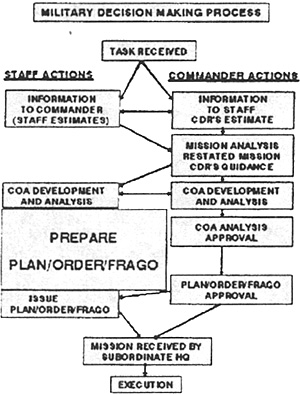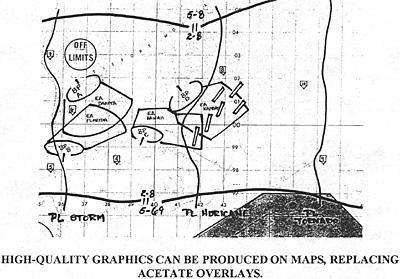 OBSERVATION:
OBSERVATION:
Commanders and staffs must be organized and prepared to produce operations orders quickly.
DISCUSSION:
Through preparation and organization, commanders and staffs can significantly decrease the time required to prepare operations orders. This begins during training and the development of standing operating procedures on how the staff produces an order. When the commander provides his planning guidance, he specifies the type of order he wants issued. He decides by considering the amount of time available and the capabilities of the staff Based on the decision, the staff implements the SOP for that type of order.
PREFORMATTED ORDERS
If the commander decides producing a written order is necessary, the staff speeds its production by using a preformatted order. The preformatted order is based on the five-paragraph operations order, but designed for the way the battalion/brigade presents its order. For example, the unit may add matrices (execution, synchronization, fire support, logistical support, or medical support) to augment each paragraph and better explain portions of its plan. With the basic format prepared, the staff fills in the blanks to complete the order.
ORGANIZING REPRODUCTION
The organization of reproduction and the unit's reproduction process can further speed the MDMP. If a written or matrix order is produced, requiring the staff to complete separate portions, then centralize the collection of the staffs completed portions. Designate a member of the staff to collect, organize, review quality and present all completed portions of the order to the S-3. The order is then given to the commander to review and approve. Once approved, the completed order is reproduced. Organizing production ensures that a complete order is reproduced as quickly as possible.
The actual reproduction also needs to be centralized. The operations sergeant identifies someone to be responsible for reproduction and provides him with a work area. Select someone other than the person responsible for compiling the order because the reproduction NCO will often have to work simultaneously with the person compiling the order while sections of the order are being published. Often the reproduction NCO receives the order from the person collecting the order who may give it to him in sections rather than wait for the order to be completed before reproduction. Whether he receives the order together or in sections, he reproduces and collates the entire order before it is disseminated. Centralizing order reproduction under the control of one person will initially require a great deal of work, but it ensures that sections of the order are not lost.
When selecting a location for reproduction, consider the equipment necessary and the amount of distraction it will cause the staff Place the reproduction area outside of the TOC so that the staff can continue to coordinate and the TOC can operate without distraction. Using a mimeograph machine or photo copier within the TOC will take up space and distract the staff from its preparations. Place the reproduction area in a tent or a built-up truck or trailer (in heavy units) so it can operate at night with interior light. This will also provide enough room for the person reproducing the order. Although moving the reproduction area away from the TOC requires extra equipment, it benefits the staff in its effort to prepare for the mission.
METHODS OF REPRODUCTION
A unit's means of reproduction can also speed the production of the order. The common method is the mimeograph (Spirit Master stencil) for reproduction of the order text and a Diazo copier or hand-drawn copies on acetate for graphics. Because of its durability, simplicity, and speed, the mimeograph method is among the best for reproducing orders. However, some photo copiers can reproduce nearly as fast with greater clarity.
For graphics, the fastest method for high-quality reproduction is to use a photo copier. To make graphic reproductions, copy the map of the area of operation, then draw the control measures onto the copy. Often this will result in several 8-inch x 11-inch pages that will have to be taped together after production.
 HIGH-QUALITY GRAPHICS CAN BE PRODUCED ON MAPS, REPLACING ACETATE OVERLAYS.
HIGH-QUALITY GRAPHICS CAN BE PRODUCED ON MAPS, REPLACING ACETATE OVERLAYS.
To begin preparing graphics early, have the S-3 Air add control measures from the brigade or division graphics (boundaries, phase lines, objectives, battle positions) that will be necessary for the order being produced by the staff. He then makes several copies for the S-3 to draw the final operational graphics. The S-3 returns the graphics to the S-3 Air who copies it for the FSO, S-4, and S-2 to use in the development of their graphics. The result of this technique will be high-quality graphics on a map eliminating the need for acetate overlays. The technique eliminates errors common in hand-drawn copies on acetate overlays. It also enables the unit to provide graphics to more subordinates - for example, battalion operational graphics for platoon leaders and logistical graphics for first sergeants.
LESSONS
- Commander: Specify through guidance the type of order to issue (written five-paragraph, oral, overlay or matrix).
- Staff: Develop a preformatted order to use for written orders.
- Staff: Organize reproduction by centralizing collection of the portions of the order and its production.
- Staff: Select an area to reproduce the order that will not interfere with the staff's work.
- Staff: Use a mimeograph or a photocopier to speed reproduction of order text.
- Staff: Use a photocopier to reproduce graphics.
Back to Table of Contents -- Battalion and Brigade Battle Staff
Back to CALL List of Issues
Back to MagWeb Magazine List
© Copyright 2004 by Coalition Web. Inc.
This article appears in MagWeb.com (Magazine Web) on the Internet World Wide Web.
Other articles from military history and related magazines are available at http://www.magweb.com